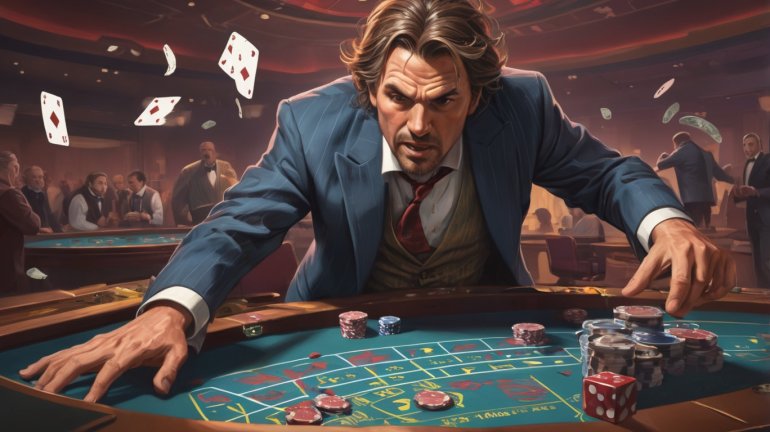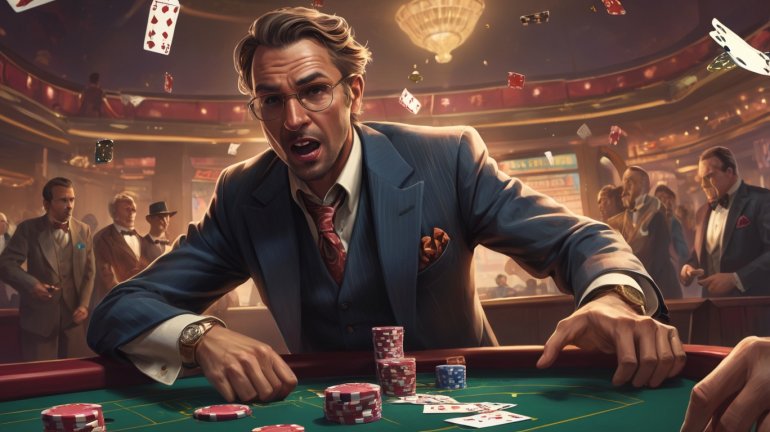
Loss aversion is a powerful psychological phenomenon that plays a significant role in human decision-making, particularly in gambling.
First identified by psychologists Daniel Kahneman and Amos Tversky, loss aversion refers to individuals' tendency to avoid losses over acquiring equivalent gains. In simple terms, the pain of losing $100 is typically felt more intensely than the pleasure of winning $100.
This cognitive bias is especially relevant in the context of gambling, where players constantly face decisions involving potential gains and losses. From casino floors to online poker rooms, loss aversion influences how players approach games, make bets, and react to outcomes. It affects everything from the strategies employed by seasoned professionals to the impulsive decisions made by casual gamblers.
Moreover, understanding loss aversion is crucial for comprehending the design and appeal of various gambling games. Game developers and casino operators often leverage this psychological principle to create more engaging and potentially addictive experiences. By tapping into players' fear of losses, they can encourage continued play and higher stakes.
This article from Casinoz explores how loss aversion significantly influences gambling behavior and game design. Are you ready for a journey across the psychology behind this phenomenon? Together, we will examine its manifestation in specific games and consider its broader implications for both gamblers and the gaming industry.
The Psychology of Loss Aversion
Loss aversion is a fundamental concept in behavioral economics and psychology that helps explain why people often make irrational decisions when faced with potential losses. At its core, loss aversion suggests that the psychological impact of losing is about twice as powerful as the pleasure of gaining an equivalent amount.
To understand loss aversion more deeply, it's important to consider related cognitive biases:
- Sunk cost fallacy: This occurs when individuals continue a behavior or endeavor due to previously invested resources (time, money, effort). In gambling, this might manifest as a player continuing to bet in hopes of recouping losses, even when the odds are unfavorable.
- Endowment effect: People tend to overvalue items they own compared to identical items they don't possess. In gambling, this can lead to players becoming overly attached to their current chip stack or betting position.
- Status quo bias: The tendency to prefer the current state of affairs. This can make gamblers reluctant to walk away from a game, even when it would be in their best interest to do so.
Key research findings on loss aversion in decision-making include:
- Prospect Theory: Developed by Kahneman and Tversky, this theory demonstrates that people make decisions based on the potential value of losses and gains rather than the final outcome.
- Asymmetric risk-taking: Studies have shown that individuals are more likely to take risks to avoid losses than to achieve gains. In gambling, this can lead to riskier bets when trying to recover losses.
- Framing effects: How a choice is presented (framed) can significantly influence decision-making. Casinos and game designers often frame gambling choices to exploit loss aversion.
- Neurological basis: Brain imaging studies have revealed that losses and gains are processed in different brain regions, with losses typically eliciting stronger and more widespread neural responses.
Comprehending these psychological underpinnings helps explain why loss aversion is such a powerful force in gambling environments.
Loss Aversion in Specific Gambling Games
Loss aversion manifests differently across various gambling games. Let's examine how it influences player behavior and game design in three popular forms of gambling.
- Near misses: When the reels stop just short of a winning combination, creating the illusion that the player almost won;
- Bonus rounds: Special game features that give players a sense of progress and the fear of missing out on potential rewards;
- Free spins: Opportunities for "free" play that make players feel they're risking less, encouraging continued engagement.
- Doubling down: The option to increase one's bet mid-hand, often driven by the fear of missing out on a potentially large win;
- Insurance bets: A side bet offered when the dealer shows an ace, appealing to players' desire to protect against potential losses;
- Splitting pairs: The choice to split a hand into two separate hands, often motivated by the fear of losing a favorable opportunity.
- Bluffing: The act of betting or raising with a weak hand, exploiting opponents' loss aversion by making them fear losing their investment in the pot;
- Chasing losses: Continuing to play and make larger bets in an attempt to recover previous losses, often leading to even greater losses;
- Pot commitment: The reluctance to fold a hand after having invested a significant amount in the pot, even when the odds are unfavorable.
In each game, loss aversion plays a crucial role in shaping player decisions and game dynamics. Game designers and casino operators often incorporate features that exploit this psychological tendency, creating experiences that keep players engaged and potentially increase revenue.
For example, slot machines use near misses and bonus rounds to create a sense of "almost winning," encouraging players to continue despite losses. In blackjack, the option to double down or take insurance appeals to players' desire to avoid or mitigate potential losses. Poker, being a game of incomplete information, provides numerous opportunities for loss aversion to influence decision-making, particularly in the concept of pot commitment.
Understanding how loss aversion operates in these specific contexts can help players make more rational decisions and potentially improve their overall gambling outcomes.
You can try the following slots for free.
| Name | Soft | Max payout | Return to player | Variance | |||
|
|
x12075 | 99% | Play | High | |||
|
|
x670 | 98.6% | Play | Low | |||
|
|
x15000 | 98.13% | Play | High | |||
|
|
x10000 | 98.12% | Play | High | |||
|
|
x500 | 98.12% | Play | Low | |||
|
|
x10000 | 98.08% | Play | High | |||
|
|
x10000 | 98.08% | Play | High | |||
|
|
x15000 | 98.03% | Play | Middle | |||
|
|
x1100 | 98% | Middle | ||||
|
|
x2500 | 98% | Low | ||||
|
|
— | 98% | Play | Low | |||
|
|
x2000 | 98% | Play | Middle | |||
|
|
x50000 | 98% | Play | High | |||
|
|
x4000 | 98% | Play | Middle | |||
|
|
x2000 | 98% | Play | Middle | |||
|
|
x1015 | 98% | Play | Low | |||
|
|
x7500 | 97.99% | Play | Low | |||
|
|
x200 | 97.9% | Play | Middle | |||
|
|
x200 | 97.88% | Play | Middle | |||
|
|
x819 | 97.84% | Play | Middle |
Real-life Examples of Loss Aversion in Gambling
To better illustrate how loss aversion affects gambling behavior, let's examine several real-life scenarios.
The "Winner's Curse"
A casino player hits a substantial jackpot on a slot machine, winning $5,000. Instead of cashing out, they continue playing, driven by the fear of "losing" their newly acquired gains. This fear often leads to prolonged play, resulting in a significant portion or even all of the winnings being lost back to the casino.
The Sports Bettor's Dilemma
A sports enthusiast places a series of bets on Sunday football games. After losing the first few bets, they feel compelled to place additional, larger wagers on later games. This behavior, known as "chasing losses," is a classic example of loss aversion in action. The bettor's desire to avoid ending the day at a loss overrides rational decision-making, often leading to even greater financial harm.
The Poker Player's Pot Commitment
During a high-stakes poker game, a player invests a large portion of their chips in a pot over several betting rounds. When faced with a final large bet from an opponent, the player suspects they might be beaten but calls anyway. The fear of losing the money already invested in the pot (the sunk cost) outweighs the rational assessment of the current situation.
The Roulette Table Trap
A roulette player bets on red for several spins, losing each time. Believing that red is "due" to come up (a manifestation of the gambler's fallacy), they increase their bets on red. This behavior is driven by the desire to recoup losses and the fear of missing out when their chosen color finally hits.
The Lottery Ticket Holder
A person who regularly buys lottery tickets refuses to change their "lucky" numbers, fearing that if they do, those numbers might come up. This irrational fear of potential regret (another aspect of loss aversion) keeps them locked into a specific behavior, despite the odds being the same for any combination of numbers.
The Casino Loyalty Program
Member A regular casino visitor accumulates points in a loyalty program, earning them various perks. Even when they want to stop gambling, the fear of losing their status and associated benefits keeps them coming back. This example shows how loss aversion can be exploited through carefully designed reward systems.
These examples demonstrate how pervasive and influential loss aversion can be in various gambling contexts.

How Casinos and Game Designers Exploit Loss Aversion
Casinos and game designers have long understood the power of loss aversion and have developed numerous strategies to exploit this psychological tendency. Their goal is to keep players engaged and encourage continued play, often leading to increased revenue.
Here are some key ways in which loss aversion is leveraged in the gambling industry:
- Game features that heighten the fear of missing out: Progressive jackpots that grow over time, creating urgency to play;
- Limited-time bonus rounds or special events;
- Countdown timers on betting decisions, pressuring players to act quickly.
Marketing strategies that emphasize potential losses:
- Advertisements highlighting "limited time offers" or "last chance" promotions;
- Messaging that focuses on what players might miss if they don't participate;
- Use of FOMO (Fear of Missing Out) in social media and email marketing campaigns.
Loyalty programs that create a sense of investment:
- Tiered reward systems where players fear losing their status;
- Points or credits that expire, encouraging regular play;
- Exclusive perks for high-level members that players are reluctant to give up.
Game design elements:
- Near-miss experiences in slot machines, creating the illusion of almost winning;
- Losses disguised as wins, where players "win" less than their original bet;
- Chip colors and denominations that psychologically distance players from real money values.
Casino layout and atmosphere:
- Absence of clocks and windows to disorient players' sense of time;
- Strategic placement of high-payout machines in visible areas;
- Complimentary drinks and services that make players feel indebted to the casino.
Betting structures:
- Minimum bet requirements that keep players in the game;
- Side bets and insurance options that appeal to loss aversion;
- Martingale-style betting systems marketed as ways to "guarantee" wins.
Virtual and online gambling innovations:
- Auto-play features that reduce the friction of continued play;
- Push notifications reminding players of unfinished games or available bonuses;
- Virtual currency systems that obscure the true value of wagers and losses.
These tactics help maintain control over gambling behavior and make more rational choices in the face of cleverly designed loss aversion triggers.

Strategies for Gamblers to Mitigate Loss Aversion
While loss aversion is a deeply ingrained psychological tendency, there are strategies that gamblers can employ to mitigate its effects and make more rational decisions:
- Determine a maximum amount you're willing to lose before playing;
- Use self-exclusion tools provided by casinos or online platforms;
- Leave credit cards and excess cash at home to avoid temptation.
Focusing on long-term results rather than short-term fluctuations:
- Keep detailed records of all gambling activities and outcomes;
- Regularly review your overall performance to maintain perspective;
- Understand that short-term losses are part of the normal variance in gambling.
Understanding and recognizing loss aversion in oneself:
- Learn to identify when emotions are driving decisions;
- Practice mindfulness techniques to stay present and aware;
- Pause and reflect before making decisions, especially after a loss.
Reframing gambling as entertainment rather than a money-making activity:
- Set a budget for gambling as you would for any other form of entertainment;
- Celebrate the experience of playing, not just winning;
- Accept that losing money is the cost of the entertainment.
Educating oneself about game odds and probabilities:
- Study the mathematical expectation of different games and bets;
- Understand the concept of house edge and how it affects long-term outcomes;
- Avoid falling for gambling fallacies like the "gambler's fallacy" or "hot hand" belief.
Using time management strategies:
- Set a strict time limit for gambling sessions;
- Use alarms or reminders to signal when it's time to stop;
- Take regular breaks to reassess your emotional state and decision-making.
Seeking support and accountability:
- Share your gambling goals with friends or family members;
- Join support groups or forums for responsible gambling;
- Consider professional help if you're struggling to control your gambling behavior.
Practicing bankroll management:
- Divide your gambling budget into smaller session amounts;
- Never chase losses or increase bets to recoup previous losses;
- Consider using the "envelope method" to physically separate funds for each session.
It's important to remember that while these techniques can be helpful, gambling always carries risks, and the most effective way to avoid losses is not to gamble at all.
| Casino | Accepted currencies | |||
| $, €, ₽, ₴ | Play | |||
| $, ₽ | Play | |||
| ₽ | Play | |||
| $, €, R$, C$ | Play | |||
| $, C$ | Play | |||
| $, C$ | Play | |||
| $, C$ | Play | |||
| $, C$ | Play | |||
| $, C$ | Play | |||
| $, C$ | Play |
Conclusion
Loss aversion is a powerful psychological force that significantly impacts gambling behavior and the design of gambling games.
Casinos and game designers have developed sophisticated methods to capitalize on loss aversion, creating games and environments that keep players engaged and potentially increase revenue. From loyalty programs to cleverly designed betting structures, the gambling industry has found numerous ways to tap into our innate fear of losses.
However, awareness is the first step towards mitigation. By understanding loss aversion and its effects, gamblers can develop strategies to make more rational decisions. Setting strict limits, focusing on long-term results, and reframing gambling as entertainment are just a few ways to counteract the pull of loss aversion.
It's crucial to remember that while gambling can be an enjoyable form of entertainment, it always carries risks. The house edge ensures that, in the long run, the odds are against the player. No strategy can completely eliminate the risk of losing money when gambling.
Ultimately, the goal is not to eradicate loss aversion – it's a fundamental part of human psychology – but to recognize its influence and make more informed choices.
By doing so, individuals can potentially enhance their gambling experiences, minimize negative outcomes, and maintain a healthier relationship with gambling activities.





















































